Concordia Steam Mill ltd

The history of the steam mills is intertwined with the history of the capital: although the steam mills were established before the unification of Buda, Pest and Óbuda in 1873, their development was influenced by the development of the economic role of the capital. In fact, the growth of the population led to a greater demand for foodstuffs, including cereals. The succession of steam mills had the advantage of being steam-driven, allowing them to be sited freely without the need for water or wind. In terms of transport, however, the proximity of the Danube was essential.
The so-called "high milling" method, which was widespread in Hungary, was as follows: the grain was first taken from the warehouse to the mill, where it was cleaned of major impurities and the husk in the milling machine. The task of the 'tarar' was to clean the wheat grain before it went to the wheat classifier, which was able to sift out the defective grains. The thresher was responsible for filtering out the kernels and the brushing machine for removing the dust. The last operation before milling was conditioning, during which water equivalent to 2-3% of the weight of the wheat grains was added to the wheat. This was followed by a resting period and then the cleaned wheat was subjected to repeated crushing to obtain a fine flour. To obtain a larger grain size, it was milled into flour using roller mills or roller pairs.
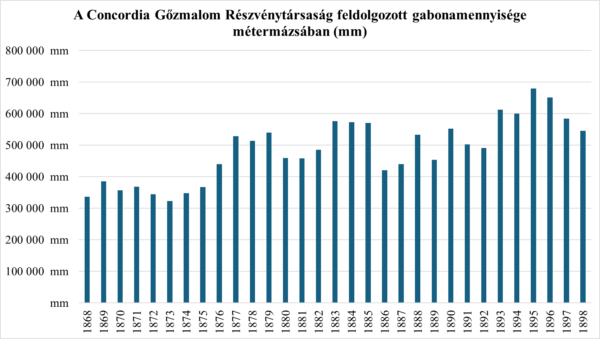
In 1865/1866, the Concordia Steam Mill Joint Stock Company was founded as one of the largest mills in Budapest, in the IX district, where most of the capital's mills were concentrated. Due to its proximity to the Danube, the mill was built on Soroksári út.
The mill's development continued unabated after the stock market crash of 1873. After that, the Hatvany-Deutsch family took over ownership of the mill. The family was then able to expand: it absorbed the companies of Zsigmond Kohner and Sons and Henrik Brüll and Sons. The first fire at the mill took place in 1892, causing 100,000 forints worth of damage, but the main buildings and equipment of the mill were saved by the firemen and soldiers who quickly arrived. As a result, there was no significant drop in the amount of grain processed by the steam mill after the 1873 crisis, nor after the fire.
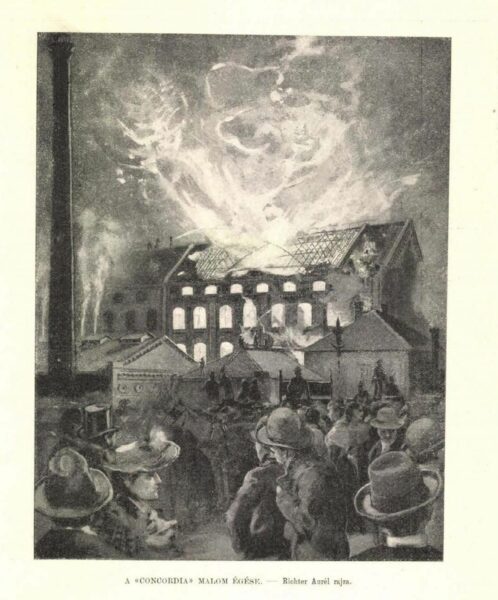
The first reorganisation of the company took place in 1901, when the financial situation of the steam mill was settled by the Hazai Bank and the company of Ignác Deutsch and Sons.On the morning of 24 January 1902, the entire mill burnt down: this was the second fire. The total loss was 2 million 420 thousand crowns. Two firemen died in the fire. This may be linked to the fall in the value of the company's share price.
In the years after the mill burnt down, it was reconstructed, while technical improvements were also made. This enabled Concordia to expand the companies in which it had a stake. In 1913, it integrated the Nagykikinda Steam Mill Joint Stock Company and in 1915 the Zsombolya Steam Mill Joint Stock Company.
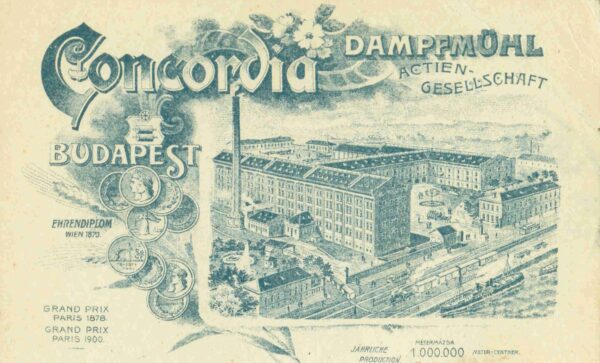
The Concordia mill, which was also considered liberal by mill workers, sought an agreement with the workers at the turn of the century. As evidence of this, a workers' welfare and pension fund was set up in 1912. As workers at the time did not have a state pension, this was a real help to Concordia's workers. Thirty years' continuous service was sufficient for a pension, while ten years' service was sufficient for disability.
A major period of crisis for the milling industry was the First World War and the period that followed. The biggest problem was that the milling industry was unable to meet the grain requirements of Trianon Hungary. 1923 was the third year of the mill fire. At the end of 1925, there was a big price rise on the international grain market, and as everyone expected prices to fall because of overproduction, Hungarian investors lost billions of crowns in a matter of days. In February 1926, the CEO Henrik Hönich committed suicide after the company's share value fell by 751T$3,000. The case was covered in detail by the press, which at first reported only on Hönich's disappearance and speculated whether his disappearance might be linked to the company's financial situation. It emerged that the company had suffered losses of billions of dollars as a result of Hönich's activities on the Chicago Stock Exchange. In addition, the 1 400 acres of land he had purchased during the First World War from his fortune in horse trading with the army administration had been seized by the courts and returned to its original owners. After losses estimated at between 20 and 30 billion crowns, the factory shut down production and dismissed 200 workers and a number of officials and management.
After many years of agonising and operating at a loss, the company was closed down in 1939 by the Patai Bank. After nationalisation, it was run by the Mills Industry Directorate, which was organised in 1948, and from 1951 it was one of the milling companies in 19 counties. Concordia was then only a warehouse. In 1978, the building was given a new function: the Milling Museum was opened, and in 1984 it became a national museum of collections, which operated until 2012. The steam mill building still stands today and serves as an office building.
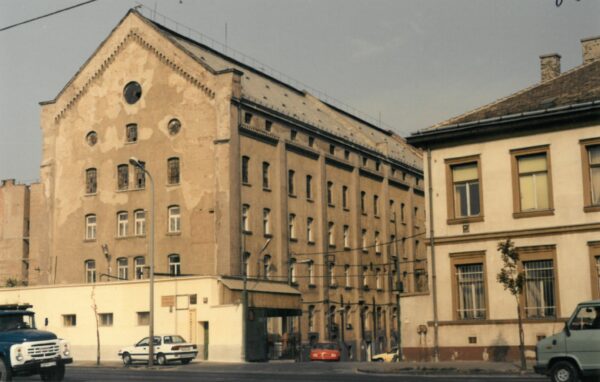
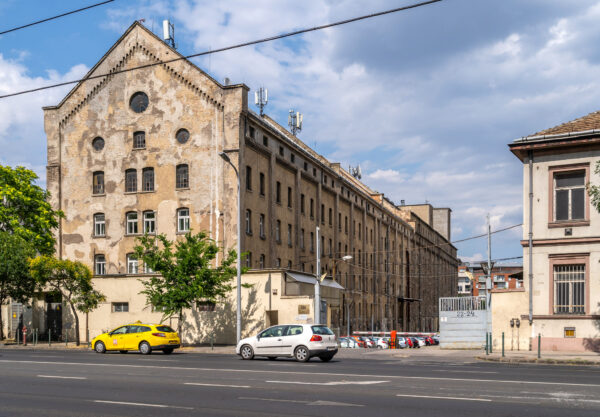
Literature used
Ágost Félegyházy - Sándor Lendvay (ed.) 1900. Description and Explanation of Securities Listed on the Budapest Stock Exchange 2.
Ferencváros was once known for its mills - Gizella and Hungária revive the past 13 July 2021. https://pestbuda.hu/cikk/20210713_ferencvaros_egykor_a_malmokrol_volt_ismert_a_gizella_es_a_hungaria_ujjaszuletve_orzi_a_multat. Pestbuda.hu
Ambrus Gönczi 2016: the Concordia: the anniversary of a world-famous mill. Honismeret (44) 4. 3-5.
Judit Klement 2012:Domestic entrepreneurs in the golden age. Entrepreneurs of the Budapest Steam Mill Industry in the Second Half of the 19th Century. Budapest.
Great Hungarian Compass 1867-1939.
Press material 1867-1939.
László Varga 1981: The Lords of Money. Varga Varga.
Date of foundation: 1865
Date of cessation: 1939
Founders: Rafael Strausz, E. A. Schopper, Jakab Perlmutter, Alajos Strobencz, Károly Rosenfeld, Gusztáv Fischl
Decisive leaders:
1874-1875 | Wiedenkeller D. |
1876-1877 | E. A. Töröry |
1878-1893 | Stephen Henry |
1894-1899 | Ágoston Csányi |
1900-1939 | Baron Károly Hatvany-Deutsch of Hatvan |
Main activity: milling industry
Main products:
wheat flour, groats, meal, bran |
Seats:
1874-1881 | Budapest IX. Soroksári-út 77. |
1882-1904 | Soroksári út 88-92. |
1905-1907 | Budapest IX. Ráday utca 88-90. |
1908-1939 | Budapest IX. Soroksári út 24. |
Author: Róbert Szabó
Date of foundation: 1865
Founders: Rafael Strausz, E. A. Schopper, Jakab Perlmutter, Alajos Strobencz, Károly Rosenfeld, Gusztáv Fischl
Decisive leaders:
1874-1875 | Wiedenkeller D. |
1876-1877 | E. A. Töröry |
1878-1893 | Stephen Henry |
1894-1899 | Ágoston Csányi |
1900-1939 | Baron Károly Hatvany-Deutsch of Hatvan |
Main activity: milling industry
Main products:
wheat flour, groats, meal, bran |
Seats:
1874-1881 | Budapest IX. Soroksári-út 77. |
1882-1904 | Soroksári út 88-92. |
1905-1907 | Budapest IX. Ráday utca 88-90. |
1908-1939 | Budapest IX. Soroksári út 24. |
Locations are not set
Main milestones are not set
Author: Róbert Szabó
Concordia Steam Mill ltd

The history of the steam mills is intertwined with the history of the capital: although the steam mills were established before the unification of Buda, Pest and Óbuda in 1873, their development was influenced by the development of the economic role of the capital. In fact, the growth of the population led to a greater demand for foodstuffs, including cereals. The succession of steam mills had the advantage of being steam-driven, allowing them to be sited freely without the need for water or wind. In terms of transport, however, the proximity of the Danube was essential.
The so-called "high milling" method, which was widespread in Hungary, was as follows: the grain was first taken from the warehouse to the mill, where it was cleaned of major impurities and the husk in the milling machine. The task of the 'tarar' was to clean the wheat grain before it went to the wheat classifier, which was able to sift out the defective grains. The thresher was responsible for filtering out the kernels and the brushing machine for removing the dust. The last operation before milling was conditioning, during which water equivalent to 2-3% of the weight of the wheat grains was added to the wheat. This was followed by a resting period and then the cleaned wheat was subjected to repeated crushing to obtain a fine flour. To obtain a larger grain size, it was milled into flour using roller mills or roller pairs.

In 1865/1866, the Concordia Steam Mill Joint Stock Company was founded as one of the largest mills in Budapest, in the IX district, where most of the capital's mills were concentrated. Due to its proximity to the Danube, the mill was built on Soroksári út.
The mill's development continued unabated after the stock market crash of 1873. After that, the Hatvany-Deutsch family took over ownership of the mill. The family was then able to expand: it absorbed the companies of Zsigmond Kohner and Sons and Henrik Brüll and Sons. The first fire at the mill took place in 1892, causing 100,000 forints worth of damage, but the main buildings and equipment of the mill were saved by the firemen and soldiers who quickly arrived. As a result, there was no significant drop in the amount of grain processed by the steam mill after the 1873 crisis, nor after the fire.

The first reorganisation of the company took place in 1901, when the financial situation of the steam mill was settled by the Hazai Bank and the company of Ignác Deutsch and Sons.On the morning of 24 January 1902, the entire mill burnt down: this was the second fire. The total loss was 2 million 420 thousand crowns. Two firemen died in the fire. This may be linked to the fall in the value of the company's share price.
In the years after the mill burnt down, it was reconstructed, while technical improvements were also made. This enabled Concordia to expand the companies in which it had a stake. In 1913, it integrated the Nagykikinda Steam Mill Joint Stock Company and in 1915 the Zsombolya Steam Mill Joint Stock Company.

The Concordia mill, which was also considered liberal by mill workers, sought an agreement with the workers at the turn of the century. As evidence of this, a workers' welfare and pension fund was set up in 1912. As workers at the time did not have a state pension, this was a real help to Concordia's workers. Thirty years' continuous service was sufficient for a pension, while ten years' service was sufficient for disability.
A major period of crisis for the milling industry was the First World War and the period that followed. The biggest problem was that the milling industry was unable to meet the grain requirements of Trianon Hungary. 1923 was the third year of the mill fire. At the end of 1925, there was a big price rise on the international grain market, and as everyone expected prices to fall because of overproduction, Hungarian investors lost billions of crowns in a matter of days. In February 1926, the CEO Henrik Hönich committed suicide after the company's share value fell by 751T$3,000. The case was covered in detail by the press, which at first reported only on Hönich's disappearance and speculated whether his disappearance might be linked to the company's financial situation. It emerged that the company had suffered losses of billions of dollars as a result of Hönich's activities on the Chicago Stock Exchange. In addition, the 1 400 acres of land he had purchased during the First World War from his fortune in horse trading with the army administration had been seized by the courts and returned to its original owners. After losses estimated at between 20 and 30 billion crowns, the factory shut down production and dismissed 200 workers and a number of officials and management.
After many years of agonising and operating at a loss, the company was closed down in 1939 by the Patai Bank. After nationalisation, it was run by the Mills Industry Directorate, which was organised in 1948, and from 1951 it was one of the milling companies in 19 counties. Concordia was then only a warehouse. In 1978, the building was given a new function: the Milling Museum was opened, and in 1984 it became a national museum of collections, which operated until 2012. The steam mill building still stands today and serves as an office building.


Literature used
Ágost Félegyházy - Sándor Lendvay (ed.) 1900. Description and Explanation of Securities Listed on the Budapest Stock Exchange 2.
Ferencváros was once known for its mills - Gizella and Hungária revive the past 13 July 2021. https://pestbuda.hu/cikk/20210713_ferencvaros_egykor_a_malmokrol_volt_ismert_a_gizella_es_a_hungaria_ujjaszuletve_orzi_a_multat. Pestbuda.hu
Ambrus Gönczi 2016: the Concordia: the anniversary of a world-famous mill. Honismeret (44) 4. 3-5.
Judit Klement 2012:Domestic entrepreneurs in the golden age. Entrepreneurs of the Budapest Steam Mill Industry in the Second Half of the 19th Century. Budapest.
Great Hungarian Compass 1867-1939.
Press material 1867-1939.
László Varga 1981: The Lords of Money. Varga Varga.